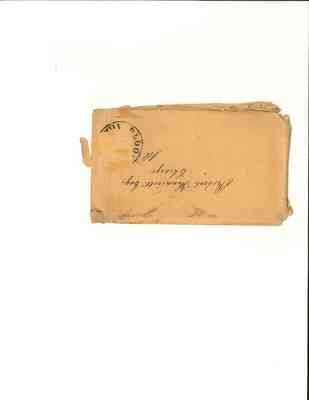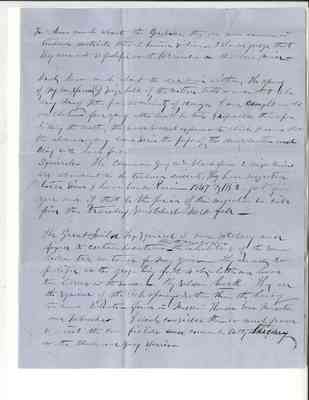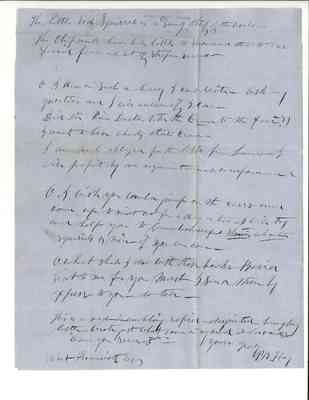Pages That Need Review
RK-196
page_0002
Robert Kennicott Esq Chicago Ill
[partial postmark] BLOO ILLS.
Rk-197
page_0001
Racine Oct 29- 1856
Dear Bob,
I will give you the benefit of all I know about our Mammals injurious to agriculture. I would prefer to furnish you with what observations I have made, rather than write out an article myself, even if I had time, for I feel a pride in your success and will cheerfully assist you so far as possible. I see by the Prairie Farmer that you have taken those spoons for your Mama.
The Pouched Gopher – Found in Missouri Kansas - Nebraska - Iowa Ill. Indiana and Southwester Wisconsin – Throws up a central mound from 6 to 10 feet in diameter – and from 1 1/2 to 3 ft high, then from this central mound they excavate extensive and complicated galeries from these galeries they open shaftes every 6 to 10 feet, from each of these holes they throw only from 1/2 to 2 bushels of dirt. The central mound is always thrown up higher in low situations than when located on high dry ground – during protracted wet weather they retreat to these large mounds where they reman safe from inundation. They live in communities – that is they are social – Only come to surface of the grond to travel about at night – they migrate during the night from one neighbourhood to another and commence new diggings. – Work mostly at night – sometimes early in the morng and late in afternoon - If an opening be made into their [illegible] they will in a short time fill it up – dont like the light hence their needs must be evil – from this peculiarity they are [repeated line] hence their deeds must be evil
page_0002
caught with a steel trap - where there has been a recent excavation the hole is opened and a small steel trap placed in such a situatn that when the gopher comes with his load of dirt to close the opening he must pass over the trap and generally puts his foot in it – Dont know how many young they have - or when they have them – If they are met during their nocturnal migrations or rambles they make no attempt to escape but give battle with the most savage determinatn to conquer or save their lives as clear as possible - spartan like – They cut corn stalks off and drag them in the holes – wheat, oats and in fact any kind of grain is devoured by them – I have known them to come up directly under a Pumpkin or a Watermellon, drill a hole on the underna excavate the inside and fill it completely full of dirt, leaving no indication that it was disturbed but to the surprise and vexation – the Pumpkin or melon was found on gathering to be worse than not unlike the [illegible] of Soda – filled with dirt –
Are you sure the large Shrew-Mole eats the Sweet potatoes? I always supposed that the whole tribe of moles were insectivorous and did more good than harm – were really a benefit than otherwise. Such is the case with Sorex Dekay otisorex [illegible] – found here – and in fact all of our moles – I dont know what species of Arvicola you refer to but I believe it is the larger specie, one that Baird considers probably new – the cinnamon coloured species is A. austerus, according to Baird – they bring forth four to six at a litter and bring fourth at least three litters during the Summer – extremely prolific – Hawks and Owls do good service in keeping them in check -
page_0003
You know much about the Gerebilla, they are more common in timbered districts, than in prairie sections – I should judge that they were not so prolific as the Arvicolas or the deer mice –
Dont know much about the deer mice either, the young of my new species(?) Seize hold of the mothers teats in order that she may drag theim from the vicinity of danger I once caught an old on who had four young attached to her teats, I separated them afer killing the mother, then made several experiments, which prooved that the alarmed young woud [illegible] the [illegible] of the dead mother and cling with much force.
Squirrels – The common grey and black species S. migratorius are abundant in the timbered districts, they have migrated north since I have been in Racine - 1847 & 1852 just five year and if that be the period of their migration we will find them traveling South-west next fall –
The Great-Tailed Fox Squirrel is more solitary and fixed to certain locations than the migratory spece – the inhabitants of the same hollow tree continue for many years – They are not so prolific as the grey – bring forth 4 at a litter and have two litters in the season – they seldom bark – They are the Squirrel of the Oak openings rather than the heavy timbered districts – found in Missouri Kansas Iowa Minesota and Nebraska – I dont consider them as much prone to visit the corn fields and commit petty larceny as the Black and Grey species –
page_0004
The little red Squirrel is a “Saucy thief of the world” – The Chipmunk have but little to recommend them to our special favor – a set of striped rascals -
O I am in such a hurry I cant write – Ask any questions and I will answer if I can – Did the [illegible] Doctor take the Crane to the fair?) I want to hear about that crane –
I am much obliged for the lette from Laurece I will profit by an acquaintance – or corespondance)
O. I. wish you would jump on the carrs and come up to visit us for a day or two – I will try and help you to some wonderful stories about squirrels & mice – if you can come –
O what shall I doo with those books Baird sent to me for you Must I send them by express to you – do tell –
This is a more rambling – rapid – disjointed bungling letter – wrote just what came in my mind at last ends
"Can you read it?" -
Yours Truly P.R. Hoy
Robet Kennicott Esq
RK-199
page_0001
Anna P.O. Union Co. Ills. Nov 6th 56
My good Friend
I write hastily in reply to yrs of the 26th ult. which has just come to hand Via Jonesboro P.O.
Please address as above and I shall get yr letters at ours instead of being delayed perhaps for weeks
At the same place I find one from your Father of the 24th
And am truly sorry to hear of his affliction. - That he may be spared in life & health to carry out his plans of usefulness to his country is the earnest wish of us all Indeed I cannot express my sorrow at hearing of his illness - shared by Mrs Ashley & his good friend Mary
As you are aware my Farming experience has been small and my observations of the habits of the animals to which you allude have been only general - Therefore I am not good authority on that subject
page_0002
[stamped] J. Kennicott Brenton Collections
[handwritten] But what I do know and think is at your service
I am informed that squirrel, (the gray.) does often injure corn by digging the newly planted seed but I have seen no instance of it. The small quantity taken by them for Food from the harvest Field is not of any consequence and I think the other much exagerated
Mice are mischievous only in the house but rats are numerous & troublesome in stacks granaries &c causing much damage.
Our grounds are over run - or rather under -mined - by moles, though perhaps they preserve rather than destroy crops by taking injurious insects - of their habits I know little. True he cuts off roots but at the same time does he not cut off more insects?
I have never seen their nests or young nor have I seen any traces of the animal during winter
Only the common gray rabbit has come under my observation
Of Field Mice the trim-built lively little deer-mouse as we call it is the only one I can find to have been seen and they
page_0003
are rare - Perhaps I should except an animal resembling the house mouse sometimes found under the corn stacks and which may be the same
The northern short tailed short legged large bodied mouse or mole found in the grass at the East is not I think known here.
I have found no trace of the gopher south of Ohio & Miss. R.R. tho he may be on some of the southern prairies of squirrels
The Gray is abundant Striped rarely or never seen Red - small - very rare Fox - perhaps one Fox squirrel to 20 gray Black - probably not found at all here
I have never seen the Fox squirrel abundant enough to give fair sport in hunting
The mole does move in the day time ie make new roads - generally in wet days - and I doubt his having any home but I am confident he travels his roads often when they are not disturbed
But I am not good authority on any of these things
However I shall enquire & write you as I get information
Truly yours L.W. Ashley
RK-200
page_0001
Philadelphia Nov. 8th 1856.
Dear Sir,
Send any or all of the specimens you mention to the Academy. We would be very glad to receive any of them, and will make a fair return in publications. The Prairie Farmer, we would not want, as it does not contain any thing in our line, though a valuable work to agriculturists.
With regard to your insects. Send Hymenoptera, Diptera, & Neuroptera to Prof. Baird. Friends of ours are engaged in studying those orders, & Baird will see to the distribution. It is not necessary to pin them, if the alcohol be sufficiently strong, or if the specimens are packed in small boxes (seidlitz powder boxes do very well) between layers of soft tissue paper; not being too dry when packed, as they will then break.
No one here studies spiders. Leidy
page_0002
talked of Myriapoda years ago, but has not done anything at them yet.
Sincerely yours John L. LeConte.
#The seeds containing grubs will be very acceptable. I shall hatch them out. Send them on when you send the other things. I am sorry the small Coleopts have been lost, but hope that next year no accident will occur.









